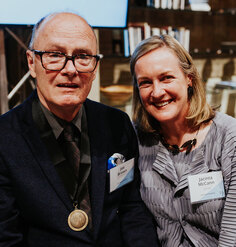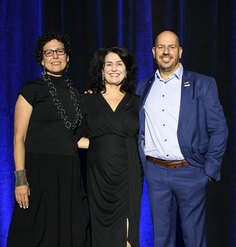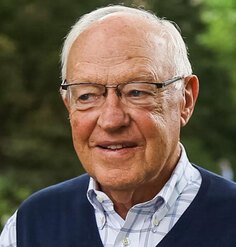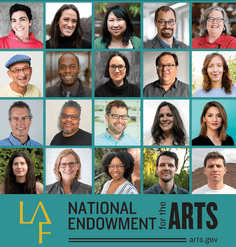In Remembrance: Grant R. Jones, FASLA
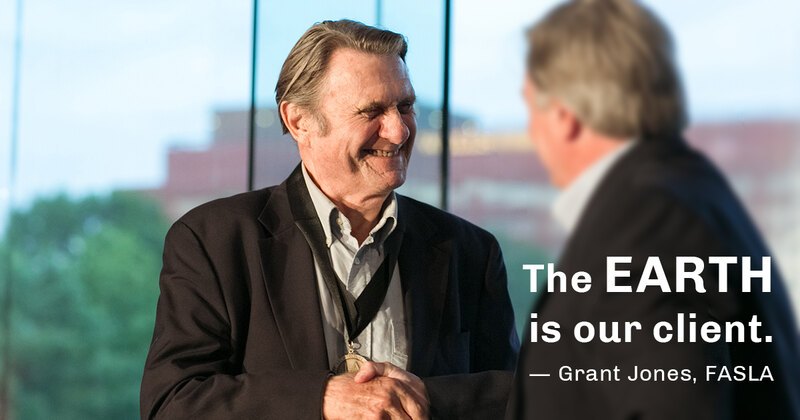
JUNE 30, 2021
The Landscape Architecture Foundation (LAF) was saddened to learn of the passing of Grant R. Jones, FASLA, on June 21, 2021, at the age of 82. Grant had an incalculable impact on LAF, the field of landscape architecture, and on the landscapes we traverse, inhabit, and find joy in.
From Grant and his firm’s pioneering work in landscape aesthetics, river planning, scenic highway design, and conservation planning, to the development of new methodologies in GIS modeling, Grant helped set the standard for environmentally responsive design. Among his many contributions, he worked to recreate natural habitats in zoos, to provide better experiences for both visitors and non-human residents, in the process “completely reinventing what it means to be a zoo,” said Dennis Carmichael, FASLA.
Grant had an early and deep connection with nature, which pervaded his life and shone through in his illustrious career. Speaking of himself, Grant said, “Growing up, he was a tide-flat beach kid on the largest brackish estuary in North America. His mentors were Dungeness crabs, cockles, lingcod and huge rays called skates.” In turn, Grant was a mentor to many over his 40 plus years as a landscape architect.
Grant contributed greatly to LAF both conceptually and operationally. He served as the Vice President of Education at LAF for eight years, bringing his experiences from various academic positions including at the University of Washington, University of California, Berkeley, Harvard, University of Oregon, University of Virginia, Texas A&M, and Ohio State.
He was the inaugural winner of the LAF Medal, which recognizes the career achievements of a landscape architect for distinguished work in applying the principles of sustainability to landscapes. LAF chose to honor Jones for his work as an early thought leader in ecological design, watershed planning, and reinventing American zoos.
“His work was transformational to the discipline and LAF,” said LAF CEO Barbara Deutsch.
Complementary, or perhaps essential to his work as a landscape architect, Grant Jones was a poet and an advocate. In his LAF Medal acceptance speech, his admonition that “The Earth is our client” embodied the energy of the moment as part of LAF's 50th anniversary celebration and 2016 Summit on Landscape Architecture and the Future. Grant continued, “The Earth is our client, our partner in a life relationship. The landscape is not a fuzzy, vague, or indefinable thing; it’s as real as your mother and father, and it’s got to be everything to you.”
Grant said he saw his speech at LAF’s 50th Anniversary Celebration in 2016 as a “Call to Action for the Next 50 Years of leadership by the landscape architectural profession as design stewards of the Earth.” Through the speech he passes the torch to the next generation, and his poignant words will serve as a touchstone for years to come. We have reprinted the speech in full below, and we encourage you to spend a few minutes reading, absorbing his words, and reflecting on how you can make an impact.
Me? I’ve run out of time, but you haven’t, and you will save the Earth! Right?
Grant Jones, FASLA
A Vision for the Next Fifty Years
Grant Jones
LAF 50th Anniversary Celebration
American Constitution Center, Philadelphia
10 June 2016
I'm deeply honored to receive this LAF Medal. It belongs to everybody in this incredible profession we proudly call landscape architecture. I cannot express the depth of my gratitude to the awards committee and LAF board, and the respect I hold for future generations to work together to make this a better world.
Good evening!
Who is this old man? He's a number of things: Growing up, he was a tide-flat beach kid on the largest brackish estuary in North America. His mentors were Dungeness crabs, cockles, lingcod and huge rays called skates. My mother, a Quaker Mendenhall (They gave the land for the first Friend's Meeting Hall here), she said: "John Bartram, our first botanist in America, was your Great Great Uncle", and she said I could do anything. So as time went by I did what landscape architects can do; I became a landscape poet, river planner, skid road urbanist, nurseryman, arboretum designer, highway designer and wildlife crossing designer.
In my lifetime I've seen Serenity created and disaster ignored, seen sweet life extirpated and beauty threw away. But I've witnessed this profession's greatness and the prospect still takes my breath away.
Landscape architects made significant contributions to our country during critical periods. Nolen, Kessler, Manning, the Olmsted family and Cleveland laid out cities connected to their regions like Madison, Boston, Minneapolis, Denver, San Diego, Roanoke, Chattanooga, and Kansas City. Kessler's El Paso tied the city park system into the mountain wilderness, and Manning's Birmingham connected this town to a statewide watershed system. We in fact laid out unique national parks connected to our cities. Cities, farms, and highways were considered a one-and-the-same design challenge. The profession continued to be advanced here by a few creative forces through the dark ages of mid-twentieth-century urban destruction. We were lifted up with McHarg's Design With Nature, layers that would become the template for GIS itself, and with Halprin's recycling of city parts when others were bulldozing them, and later when Halprin listened to the wind and sheep to teach us how to inhabit a wild coastline. And of course, we were saved with Jensen's topologies for a whole region and with Phil Lewis's strategies for a river-structured nation. At Jones & Jones, we simply learned to discover all the parts of the watershed, name them, love them and let them be themselves. Shaping cities and countryside as one boiled down to a design problem and this profession was created to do it. Are we currently contributing this same leadership from within our ranks?
What did he just say? I said: Landscape architecture was invented in the United States of America in the mid 19th century, inspired by Ralph Waldo Emerson and Henry Thoreau as an extension of the Arts & Crafts Movement with the mission to shape a new nation, protect its unique and scenic landscapes from harm, and to serve new burgeoning communities through design. Landscape architecture here was created to design cities and preserve intrinsic landscapes, and forthwith this profession gave a new identity to ALL Americans as steward-owners of wild and scenic landscape monuments across the country, gave them their identity as Americans. We were trained to design armatures of parks and greenways for humans and animals, and to heal the broken landscapes of progress. Quite a mission! As doctors to heal nature and communities, as writers to write about the qualities of the American landscape, as leaders to serve in our communities and wherever commissioned, and, as teachers and practitioners, to educate our students and inspire our team members.
This mission of ours was more than horticulture or what's now referred to around the English-speaking world as landscaping. To be a professional doctor of the landscape you have to have an in-depth knowledge of Earth's natural systems from climate and landform to plants and animals and human societies, and be an artist and a writer who is fascinated with people and animals. You also have to love scientists, but stand, and lead them, as community activists. You have to teach this healing mission in our schools. And do the research to cultivate it all and make it visible. More importantly, at all levels, you have to tell stories to pass it on.
We couldn't achieve this through design and art alone, but through the relationships, we formed with clients. Clients have a double identity--the people themselves; and the land they stand on. You serve clients by designing places for them to stand as partners with the land that they own in the fabric of their communities. Customers and communities deserve credit also.
That's the inheritance. You're really here to serve the Earth. This is not a philosophy. You must listen to her; engage with Earth as a partner. Don't allow yourself to get confused. Ask Earth to teach you, ask her how to design each project. If we respect her anatomy and do our best to inhabit the right positions on her ground, our secondary client who's agreed to pay the bills learns how to fit her like a glove.
This is my message. The Earth is our client, our partner in a life relationship. The landscape is not a fuzzy, vague or indefinable thing; it's as real as your mother and father, and it's got to be everything to you. Right now she's a compromised patient. It will be your job to help her get her strength back. If she dies, you die.
Forget about monuments. Regard trees as cathedrals. Understand the architecture of rivers. Remember your WORDS are as powerful as your plans. The real opportunities are at home. Take leadership over your home rivers, over your roads and green infrastructure, and over your city places, all of them. Remember, engineers are just engineers, architects just architects, scientists just scientists. None of them are trained to do what you're trained to do.
And remember, there's no landscape without people; we leave stories, and we leave marks and spirits behind embedded and abiding in the landscape. But here's the thing. The animals know more than you do. The animals learn more than we do. Learn from them. Then stand up as doctors, as stewards, as poets representing all life forms.
Make it your job to be lifelong students without the answers, who listen and examine problems. So get used to going where everything is out of control and learn to feel comfortable in places where nobody has the answers. You have no other choice. Systems have fallen apart. I'm not talking about bridges and downspouts. I'm talking about real world-class nature infrastructure like salmon runs threatened in your neighborhoods, deserts riddled with weeds, ancient estuaries suffocating, coastal villages engulfed by rising seas, beaches disappearing for lack of migrating sand, unnatural human-suppressed forest infernos spreading, cities and counties who are never cooperating, neighborhoods losing their identity, farm families dying out, highway contusions everywhere that could be healings for human neighborhoods and animal communities, scenic viewsheds expunged. Indigenous leaders are way ahead of us. They're looking for other leaders of the landscape. They want to collaborate. Walk in on them. Offer to help our American Indian elders. They have considerable clout and great leadership ability.
These environmental collapses have to become landscape-architect-led design problems. If we demonstrate in the community and teach our students that "the landscape architect approach" to design, (with designs led and managed by landscape architects), provides greenways, scenic highways, wetland preserves, interpretive parks, paths between neighbors, wildlife-connectors, scenic overlooks, urban commons, farmer's markets, meeting parks, processionals, energized healthy cities.
Ignore architects and engineers as leaders. Stand up and serve people not agencies. Do your special analysis; invent your unique mapping. Know more about your regional landscape than anybody else. Be the champion of your neighborhood places. Be the landscape poets of this incredibly diverse, individually particular, physically exciting, intriguingly weird landscape of ours.
You've signed on to a creed and assumed a responsibility to take care of the Earth; that's your calling. That's the promise you made. This profession matured over 150 years. Will we keep maturing like the profession stood up? Will we regard the future as important and not leave a wreck? Perhaps we're a dying profession? Over my dead body! I refuse to be part of the wreck. We stand on a creed of healing—and that is our art.
Everything on this planet is reaching out to you. Every animal and plant, every place reaches out to you to be its partner. We're Earth designers, and we must think as poets. Write a poem every week. And, because one-quarter of our country is Latino, we'd better start learning to think in Spanish.
Hay Palabras-There Are Words
Hay palabras
There are words
que cuentan la historia
which tell the story
como hojas en la tierra
like leaves on the ground
son mensajes.
make messages.
Hay palabras
There are words
doblandose como arboles en el viento
like trees bending in the wind
que cuentan la historia
which tell the story
de corazones no vencidos.
of hearts holding on.
Hay palabras
There are words
que cuentan la historia
which tell the story
como las piedras que hacen las playas
like small rocks making beaches
que cuentan historias silencios.
speak histories.
Hay palabras
There are words
que echan raices
which root
y sostienen las montanas.
and hold the hills from overturning.
Hay palabras.
There are words.
Me? I've run out of time, but you haven't, and you will save the Earth! Right?
Thank You!
GRJ
